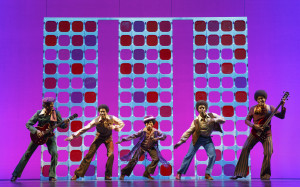
Music legends like Diana Ross, Stevie Wonder and The Jackson 5 may have been accustomed to a big stage and bright lights by the peak of their careers, but they all started somewhere a little more humble. For these stars in particular, their stories began at Motown, a Detroit-based record company founded by the ambitious Berry Gordy Jr. during the civil rights movement.
Gordy was intent on making his American Dream come true. He wanted the African-American musicians of his independent record company to be nationally recognized for their unique pop and soul sound. Even after doing so, his dream didn’t stop there. It was Gordy himself who developed the jukebox musical about his journey, which is loosely based on his autobiography. It first premiered on Broadway last year
On the night of Aug. 19, Hitsville U.S.A. — Motown’s original’s headquarters — was in San Francisco’s historic Orpheum Theatre.
The show began with a medley of lively musical numbers performed by the ensemble. The energy in this introduction was fiery and electric, and thankfully, the fire did not burn out quickly. The cast tirelessly maintained their smiles and upbeat dance moves throughout the show.
With over 60 songs in the show, “Motown” illustrates the history of pop music brilliantly, but leaves much to be desired in regards to traditional storytelling. There are only a few instances in which the characters — Gordy, his investors and his clients — could manage to have a decent conversation before bursting into song. The first act especially needs more dialogue in order for the audience to fully understand the beginnings of Motown and its rising stars. Songs like “Cruisin’” and “My Girl” are samples of the pop-influenced music that pervaded the mid-20th century, but they give little insight into any backstory.
Still, relationships between the characters were clearly defined on stage. Gordy’s (Clifton Oliver) chemistry with his client, Smokey Robinson (Nicholas Christopher), established the two as lifelong best friends. Flirtatious glances and laughter between Gordy and Diana Ross (Allison Semmes) foreshadow their eventual romance. Numerous interactions between Gordy and his family reveal his many dreams and how his family hesitantly but lovingly supported him through it.
The show finds success whenever actors break the fourth wall or interact with the audience. When Ross ends her romance with Gordy and leaves Motown Records, the story reaches one of its saddest moments, but members of the audience cannot not help but root for Ross as she appears on stage alone in a glittering white dress and invites guests to sing her famous “Reach Out and Touch” with her.
Grand, sparkly costumes like Ross’ definitely dazzle onstage, but the evolution of the characters’ wardrobe over decades is far more impressive. The show’s exposition takes place in the late 1950s. This was years before high school seniors Florence Ballard (Krisha Marcano), Ross and Mary Wilson (Trisha Jeffrey) ever became The Supremes, and they wore modest floral dresses with A-line skirts. In the 1960s, the hemlines on their dresses reduce significantly, and even later in the story, costumes take on the colorful hippie look of the 1970s counterculture.
The backdrops of “Motown” only add to the vibrancy of the costumes. Though props and furniture are simple, sets are changed constantly so the audience is never staring at one thing for too long. A wooden blue-and-white frame with “Hitsville U.S.A.” carved into the front represents the entirety of Motown’s Detroit headquarters.
The second act covers Motown’s relocation to Los Angeles. The background is most elaborate at this point, with a fancy recording studio and a stately office to represent the glamour of California instead of Michigan’s Midwestern charm. The second act also seems to progress much more quickly than the first half. Once Gordy discovered The Jackson 5, it is clear that Motown stars are headed for extraordinary fame. Reed L. Shannon, who plays young musical prodigy Michael Jackson, wows the audience with his powerhouse voice and captivating grin.
The glitz, glamour and expenses of Los Angeles left Motown to struggle as an independent label, as media conglomerates grew even bigger. Though he was bitter that the music industry had changed, Gordy still found himself at the 25th anniversary of the Motown-inspired television show, surrounded by old friends.
On Aug. 19, the real Berry Gordy, now 84, appeared on stage beside the actor playing his character, and the Orpheum erupted into cheers and standing ovations and everyone took their bows. The energy of the cast had projected onto the audience, and it was easy to tell that the show had found great success with its catchy songs and dances, just like Motown Records’ many stars once did.
“Motown: The Musical” is in San Francisco’s Orpheum through Sept. 28.
